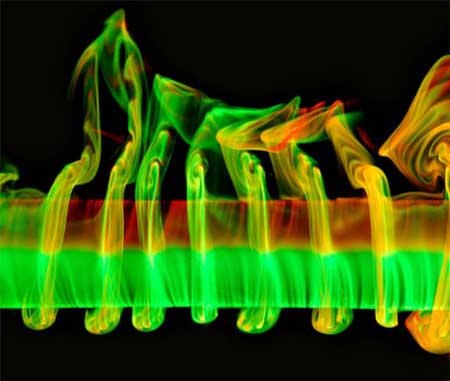Centrifugal Instability of an Oscillating Boundary Layer

A cylinder twisting back and forth in water, produces a "centrifugal instability," as shown by fluorescent dye. This fluid pattern will not only help scientists better understand ocean dynamics, but it is also aesthetically beautiful.
Image credit: Miguel Canals/University of Hawaii
A cylinder twisting back and forth in water produces a "centrifugal instability," as shown by fluorescent dye.
As fluid flows over a vibrating cylinder, the liquid closest to the cylinder (called boundary layer flow) becomes unstable due to variations in angular momentum.
This image illustrates the beginning and development of what are called Görtler vortices. A cylinder was vibrated using a computer-controlled stepper motor in glass tank. To observe the fluid flow, fluorescent dye was used on alternate sides by saturating cotton thread with the different colors, and embedding the thread into thin slits carved on the cylinder surface.
Flow visualizations were obtained by ultraviolet fluorescence which is the same effect that makes your teeth glow under a black light.
Understanding the dynamics of these fluid vortices has important implications in studying pressure distribution on cylindrical structures in ocean engineering.
Aspects of this project are funded by the National Science Foundation. Collaborators include Miguel Canals (APS member) and Geno Pawlak (adviser) of the Department of Ocean and Resources Engineering, School of Ocean and Earth Science and Technology, University of Hawaii.











